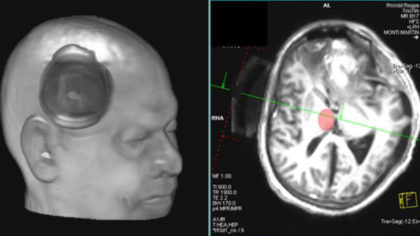- Home
- Editorial
- News
- Practice Guidelines
- Anesthesiology Guidelines
- Cancer Guidelines
- Cardiac Sciences Guidelines
- Critical Care Guidelines
- Dentistry Guidelines
- Dermatology Guidelines
- Diabetes and Endo Guidelines
- Diagnostics Guidelines
- ENT Guidelines
- Featured Practice Guidelines
- Gastroenterology Guidelines
- Geriatrics Guidelines
- Medicine Guidelines
- Nephrology Guidelines
- Neurosciences Guidelines
- Obs and Gynae Guidelines
- Ophthalmology Guidelines
- Orthopaedics Guidelines
- Paediatrics Guidelines
- Psychiatry Guidelines
- Pulmonology Guidelines
- Radiology Guidelines
- Surgery Guidelines
- Urology Guidelines
Breakthrough: Ultrasound used to wake up patient out of Coma

Los Angeles: In a first, scientists in the US have used low-intensity ultrasound to successfully jump-start the brain of a 25-year-old man recovering from coma, an advance that may lead to a portable device that can non-invasively 'wake up' patients who are in vegetative state.
The technique uses sonic stimulation to excite the neurons in the thalamus, an egg-shaped structure that serves as the brain's central hub for processing information.
The patient has made remarkable progress following a treatment, researchers said. "It's almost as if we were jump-starting the neurons back into function," said Martin Monti, from University of California, Los Angeles.
"Until now, the only way to achieve this was a risky surgical procedure known as deep brain stimulation, in which electrodes are implanted directly inside the thalamus," Martin Monti said.
 Left, a 3-D reconstruction of the patient's head wearing the ultrasonic device. Right, a cross-section view of the device, the patient's brain and the target (the thalamus), in red. Source: MARTIN M. MONTI/UCLA
Left, a 3-D reconstruction of the patient's head wearing the ultrasonic device. Right, a cross-section view of the device, the patient's brain and the target (the thalamus), in red. Source: MARTIN M. MONTI/UCLA"Our approach directly targets the thalamus but is noninvasive," he added.
Martin Monti cautioned that the procedure requires further study on patients before they determine whether it could be used consistently to help other people recovering from comas.
Researchers used a device about the size of a coffee cup saucer which creates a small sphere of acoustic energy that can be aimed at different regions of the brain to excite its tissue.
They placed it by the side of the man's head and activated it 10 times for 30 seconds each, in a 10-minute period. Mr Monti said the device is safe because it emits only a small amount of energy - less than a conventional Doppler ultrasound.
Before the procedure began, the man showed only minimal signs of being conscious and of understanding speech - for example, he could perform small, limited movements when asked.
By the day after the treatment, his responses had improved measurably. Three days later, the patient had regained full consciousness and full language comprehension, and he could reliably communicate by nodding his head "yes" or shaking his head "no."
The technique targets the thalamus because, in people whose mental function is deeply impaired after a coma, thalamus performance is typically diminished.
Medications that are commonly prescribed to people who are coming out of a coma target the thalamus only indirectly. The researchers plan to test the procedure on several more people.
If the technology helps other people recovering from coma, Mr Monti said, it could eventually be used to build a portable device - perhaps incorporated into a helmet - as a low-cost way to help "wake up" patients, perhaps even those who are in a vegetative or minimally conscious state.
Currently, there is almost no effective treatment for such patients, he said.
A report on the treatment is published in the journal Brain Stimulation. This is the first time the approach has been used to treat severe brain injury.
You can read the full reports from the following link:
http://www.brainstimjrnl.com/article/S1935-861X(16)30200-5/fulltext

Disclaimer: This site is primarily intended for healthcare professionals. Any content/information on this website does not replace the advice of medical and/or health professionals and should not be construed as medical/diagnostic advice/endorsement or prescription. Use of this site is subject to our terms of use, privacy policy, advertisement policy. © 2020 Minerva Medical Treatment Pvt Ltd